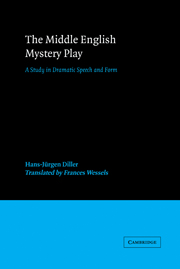Book contents
- Frontmatter
- Contents
- Preface
- Note on texts used
- Abbreviations and special symbols
- Introduction
- Part I The foil: Latin church drama
- Part II The English Creation to Doom cycle
- 5 The origins of the Creation to Doom cycle and its stage
- 6 The representation of time and space in the cycles
- 7 Address to the audience
- 8 Intra-dramatic speeches
- 9 Conclusions
- Notes
- Bibliography
- Indexes
5 - The origins of the Creation to Doom cycle and its stage
Published online by Cambridge University Press: 04 March 2010
- Frontmatter
- Contents
- Preface
- Note on texts used
- Abbreviations and special symbols
- Introduction
- Part I The foil: Latin church drama
- Part II The English Creation to Doom cycle
- 5 The origins of the Creation to Doom cycle and its stage
- 6 The representation of time and space in the cycles
- 7 Address to the audience
- 8 Intra-dramatic speeches
- 9 Conclusions
- Notes
- Bibliography
- Indexes
Summary
Before we begin the study of the vernacular drama it is necessary to inquire into any continuity that may exist between the mystery cycles and the liturgical drama. When the German original of this book was published it was still usual for the standard histories to say that the vernacular genres had ‘developed’ out of the Latin. How exactly such development had taken place was not so clear. When the evolutionism of the generation of Chambers and Creizenach had fallen into disrepute, the incertitude about the nature of that evolution increased still further. Hardin Craig, who wrote the last one-man history of our genre, is probably representative of that watered-down evolutionism:
We know that liturgical plays or dramatic offices were in the hands of the clergy and that during a period of perhaps slightly more than 100 years, roughly from the beginning of the thirteenth to the beginning of the fourteenth century, the plays left the church and passed into the hands of the laity. How and why they did this we do not know with any great definiteness.
Craig would probably have rejected the charge of biologism, but his wording - ‘left the church and passed into the hands of the laity’ - still reflects the notion that between the liturgical drama of the twelfth and the mystery plays of the fourteenth and fifteenth centuries there must have existed an uninterrupted line of progeny pretty much as it is postulated by biologists when they claim the descent of one species from another. Such thinking will always be on the lookout for transitional forms which share some of their features with the earlier, some with the later species.
- Type
- Chapter
- Information
- The Middle English Mystery PlayA Study in Dramatic Speech and Form, pp. 71 - 78Publisher: Cambridge University PressPrint publication year: 1992



